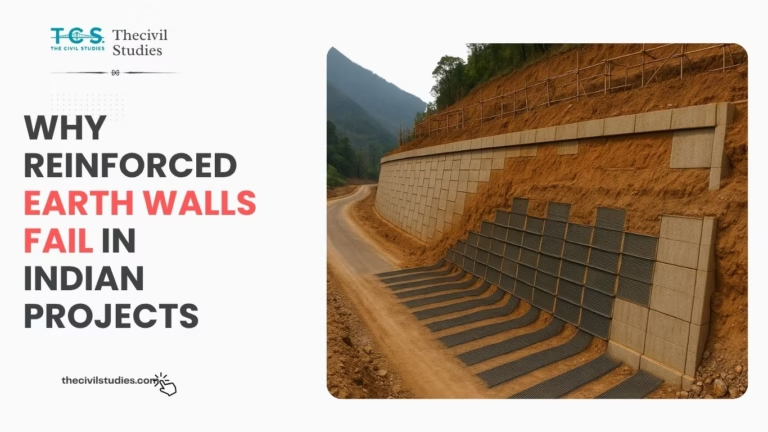Stretching across the Chenab River gorge in Jammu & Kashmir, the Chenab Rail Bridge doesn’t just claim the title of the world’s tallest railway bridge—it stands as a testament to human ingenuity in one of the most challenging environments on Earth.
Built 359 meters above the river, this structure weaves together advanced materials, precision engineering, modular construction, and forward-thinking design.
1. Steel Arch & Load Distribution
467 m Dual‑Rib Arch Structure
At its core lies a 467-meter two-rib steel arch. Each rib efficiently transfers all vertical (live and dead) loads directly into bedrock-anchor abutments—crucial when facing the seismic instability of the Himalayas. Carefully calculated radial convergence and annular stiffening ribs minimize flexural stresses at mid-span.
Concrete-Filled Box-Section Strategy
Engineers used E410-grade steel box sections, each sealed and then infilled with concrete. This hybrid solution enhances overall stiffness and leverages internal damping to mitigate both wind-induced oscillations and low-frequency train vibrations—problems common in long-span bridges.
Thermal Expansion Accommodated by Bearings
Custom pot and spherical bearings accommodate lateral and rotational movements. The bridge is designed to handle ±30 mm of thermal expansion—thanks to the extreme Himalayan range from –20 °C to +50 °C.
2. Breakthrough Construction Techniques: Cantilevers & Cable Cranes
2. Modular Construction & Precision Assembly
Gigantic Cable-Crane Setup
A bespoke cross-gorge cable crane, among the tallest and most precise in the world, transported massive arch segments across a 359-meter chasm. Placement precision at the millimeter level ensured seamless fit between prefabricated steel components.
Double-Cantilever Assembly Method
Constructed incrementally from both banks, the two halves of the arch met at the crown in April 2021. This cantilevering method demanded extraordinary geometric control, calculated hoisting sequences, and synchronized closure to maintain load redistribution.
Incremental Deck Launch on a Curved Geometry
Deck segments were methodically launched into position along a curve with continuously varying radius—an engineering first for such a configuration in India. Transition curves and parabolic alignment were modeled to keep bending moments within allowable limits during static and dynamic loading.
Ground Improvement via Grouting
Foundations sit in loose glacial till prone to voids and settlement. High-pressure consolidation grouting was used before erecting piers to minimize post-construction settlement and improve load-bearing reliability.
3. Resilience: Seismic, Blast & Wind Resistance
Earthquake & Explosion Resistance
Designed to withstand seismic forces of intensity ~M8 and explosions up to 40 kg TNT, structural stability is reinforced with 63 mm thick blast-resistant plates, ductile detailing of connections, and robust pier reinforcement to avoid catastrophic failure.
Wind Tunnel Testing for Safety
Extensive testing in Norway’s Force Technology Lab simulated wind loads up to 266 km/h. Results informed aerodynamic profiling, bike-bracing addition, and appropriate mass distribution to avoid vortex shedding and resonance phenomena.
Redundancy Through Load Path Duplication
The bridge incorporates redundant pathways such that, should a primary pier fail, secondary beams and arch ribs share load, allowing trains to traverse at reduced speeds while emergency protocols take effect.
Long-Term Corrosion Protection
The exterior features a multi-layer epoxy and polyurethane paint system, promising 15 years of lifecycle protection. All exposed welds and fasteners are seal-welded, with special weatherproof silicone to seal panel joints.
4. Digital Engineering & Global Collaboration
BIM Precision with Tekla
The entire structure—every bolt, splice, and nut—was modeled in Tekla Structures, allowing clash detection, manufacturing tolerance tracking, and component-level traceability. Fabrication drawings and erection sequences were generated directly from the BIM model.
Cross-Border Expertise
Engineers from India, Norway, Germany, Switzerland, and Finland collaborated across wind analysis, seismic detailing, offshore steel manufacturing, and load testing protocols, integrating best practices and cross-verified calculations.
5. Terrain Logistics & Ecological Considerations
Access Infrastructure in a Remote Gorge
Construction hinged on 11 km and 12 km of access roads on opposite banks. Heavy lift was managed via cable cranes, helicopters, and donkey caravans for small materials—each transport mode tracked and scheduled to site-specific tolerances.
Eco-Sensitive Elevation Strategy
At 359 m above the river’s high‑flood level, the bridge vertical clearance was optimized to prevent floodplain encroachment, safeguard wildlife habitats, and preserve riverbed integrity—key in Himalayan ecologies.
Engineering Innovation Summary
| Innovation | Details |
| Steel Arch Design | Dual‑rib, 467 m span; concrete‑filled box trusses |
| Cable Crane System | World’s tallest crane system; precision segment placement |
| Cantilever Construction | Arch built from both banks, joined seamlessly at crown |
| Seismic/Blast Resistance | Supports M8 quakes, 40 kg TNT blasts; ultra‑thick blast‑steel |
| Wind Tunnel Testing | Validated at 266 km/h wind speeds by Norway’s testing labs |
| Digital Model (BIM) | Tekla‑driven planning eliminated fitting errors and assembly clashes |
| Corrosion Protection | Multi‑coat system with 15‑year lifespan in Himalayan conditions |
| Smart Monitoring System | Live data feed for structural health enables proactive maintenance |
| Multi‑Modal Integration | Future‑proofed for pedestrians and cyclists alongside rail operations |
Engineer’s Takeaways – Key Learning Points
- Material Innovation: Combining E410 steel with concrete backing enhances flexural rigidity and vibration control.
- Precision Execution: Detailed BIM modeling and high-accuracy erection are vital for assemblies with millimeter-level tolerances.
- Extreme Resilience: Designing for seismic shocks, blast scenarios, and hurricane-force winds builds lasting infrastructure.
- Modular & Adaptive Construction: Prefabricated megasegments with high-pressure grouting and cantilever methods suit rugged, remote terrains.
- Sustainable Design: Integrated monitoring systems and public-access amenities extend the bridge’s lifecycle and social impact.





